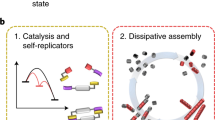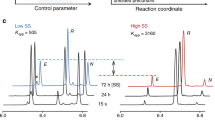Abstract
Enzymatic reaction networks capable of generating complex spatiotemporal dynamics are not only the basis of essential biological processes, but also the basic units of synthetic systems with autonomous, adaptive and programmable behaviours. Activation and inhibition have been usually considered as indispensable interactions for the construction of such networks. Here we present an enzymatic reaction network that consists of a flavin adenine dinucleotide-dependent oxidoreductase and a peroxidase that can generate tunable complex dynamics. These include charging/discharging, rectangular and parabolic pulses in a closed system, which are based on delayed and self-adapting substrate competition, rather than on activation or inhibition. Additionally, this system can spontaneously form visible spatiotemporal patterns that arise from reaction-driven Rayleigh–Bénard convection. This work demonstrates that substrate competition could be an alternative path towards constructing biochemical networks with complex dynamics.
This is a preview of subscription content, access via your institution
Access options
Access Nature and 54 other Nature Portfolio journals
Get Nature+, our best-value online-access subscription
$29.99 / 30 days
cancel any time
Subscribe to this journal
Receive 12 digital issues and online access to articles
$119.00 per year
only $9.92 per issue
Buy this article
- Purchase on Springer Link
- Instant access to full article PDF
Prices may be subject to local taxes which are calculated during checkout




Similar content being viewed by others
References
van Roekel, H. W. H. et al. Programmable chemical reaction networks: emulating regulatory functions in living cells using a bottom-up approach. Chem. Soc. Rev. 44, 7465–7483 (2015).
Kondo, S. & Miura, T. Reaction–diffusion model as a framework for understanding biological pattern formation. Science 329, 1616–1620 (2010).
Grzybowski, B. A. & Huck, W. T. S. The nanotechnology of life-inspired systems. Nat. Nanotechnol. 11, 584–591 (2016).
Merindol, R. & Walther, A. Materials learning from life: concepts for active, adaptive and autonomous molecular systems. Chem. Soc. Rev. 46, 5588–5619 (2017).
Vanag, V. K. & Epstein, I. R. Segmented spiral waves in a reaction–diffusion system. Proc. Natl Acad. Sci. USA 100, 14635–14638 (2003).
Semenov, S. N. et al. Autocatalytic, bistable, oscillatory networks of biologically relevant organic reactions. Nature 537, 656–660 (2016).
Brophy, J. A. N. & Voigt, C. A. Principles of genetic circuit design. Nat. Methods 11, 508–520 (2014).
Lim, W. A. Designing customized cell signalling circuits. Nat. Rev. Mol. Cell Biol. 11, 393–403 (2010).
Lu, T. K., Khalil, A. S. & Collins, J. J. Next-generation synthetic gene networks. Nat. Biotechnol. 27, 1139–1150 (2009).
Novak, B. & Tyson, J. J. Design principles of biochemical oscillators. Nat. Rev. Mol. Cell Biol. 9, 981–991 (2008).
Basu, S., Mehreja, R., Thiberge, S., Chen, M. T. & Weiss, R. Spatiotemporal control of gene expression with pulse-generating networks. Proc. Natl Acad. Sci. USA 101, 6355–6360 (2004).
Han, D. et al. A cascade reaction network mimicking the basic functional steps of adaptive immune response. Nat. Chem. 7, 836–842 (2015).
Okar, D. A., Wu, C. & Lange, A. J. Regulation of the regulatory enzyme, 6-phosphofructo-2-kinase/fructose-2,6-bisphosphatase. Adv. Enzyme Regul. 44, 123–154 (2004).
Kholodenko, B. N. Cell-signalling dynamics in time and space. Nat. Rev. Mol. Cell Biol. 7, 165–176 (2006).
Jensen, K. J., Moyer, C. B. & Janes, K. A. Network architecture predisposes an enzyme to either pharmacologic or genetic targeting. Cell Syst. 2, 112–121 (2016).
Semenov, S. N. et al. Rational design of functional and tunable oscillating enzymatic networks. Nat. Chem. 7, 160–165 (2015).
Nijemeisland, M., Abdelmohsen, L. K. E. A., Huck, W. T. S., Wilson, D. A. & van Hest, J. C. M. A compartmentalized out-of-equilibrium enzymatic reaction network for sustained autonomous movement. ACS Cent. Sci. 2, 843–849 (2016).
Kim, S. Y. & Ferrell, J. E. Substrate competition as a source of ultrasensitivity in the inactivation of Wee1. Cell 128, 1133–1145 (2007).
Gibson, Q. H., Swoboda, B. E. P. & Massey, V. Kinetics and mechanism of action of glucose oxidase. J. Biol. Chem. 239, 3927–3934 (1964).
Zhao, J., Lu, C. & Franzen, S. Distinct enzyme–substrate interactions revealed by two- dimensional kinetic comparison between dehaloperoxidase-hemoglobin and horseradish peroxidase. J. Phys. Chem. B 119, 12828–12837 (2015).
Zhang, Y., Wang, Q. & Hess, H. Increasing enzyme cascade throughput by pH-engineering the microenvironment of individual enzymes. ACS Catal. 7, 2047–2051 (2017).
Campbell, J. A. Kinetics—early and often. J. Chem. Educ. 40, 578–583 (1963).
Rajchakit, U. & Limpanuparb, T. Greening the traffic light: air oxidation of vitamin C catalyzed by indicators. J. Chem. Educ. 93, 1486–1489 (2016).
Belintsev, B. N. Dissipative structures and the problem of biological pattern-formation. Sov. Phys. Usp. 26, 775–800 (1983).
Turing, A. M. The chemical basis of morphogenesis. Phil. Trans. R. Soc. Lond. B 237, 37–72 (1952).
Manneville, P. in Dynamics of Spatio-temporal Cellular Structures (eds Mutabazi, I., Wesfreid, J. E. & Guyon, E.) 41–46 (Springer, New York, 2006)..
Avnir, D. & Kagan, M. Spatial structures generated by chemical reactions at interface. Nature 307, 717–720 (1984).
Nagypal, I., Bazsa, G. & Epstein, I. R. Gravity-induced anisotropies in chemical waves. J. Am. Chem. Soc. 108, 3635–3640 (1986).
Rajchakit, U. & Limpanuparb, T. Rapid blue bottle experiment: autoxidation of benzoin catalyzed by redox indicators. J. Chem. Educ. 93, 1490–1494 (2016).
Pons, A. J., Sagués, F., Bees, M. A. & Sørensen, P. G. Pattern formation in the methylene-blue−glucose system. J. Phys. Chem. B 104, 2251–2259 (2000).
Sengupta, S. et al. Self-powered enzyme micropumps. Nat. Chem. 6, 415–422 (2014).
Ortiz-Rivera, I., Shum, H., Agrawal, A., Sen, A. & Balazs, A. C. Convective flow reversal in self-powered enzyme micropumps. Proc. Natl Acad. Sci. USA 113, 2585–2590 (2016).
Das, S. et al. Harnessing catalytic pumps for directional delivery of microparticles in microchambers. Nat. Commun. 8, 14384 (2017).
Yang, Y., Verzicco, R. & Lohse, D. From convection rolls to finger convection in double-diffusive turbulence. Proc. Natl Acad. Sci. USA 113, 69–73 (2016).
Yang, Y. et al. Salinity transfer in bounded double diffusive convection. J. Fluid Mech. 768, 476–491 (2015).
Rongy, L., Trevelyan, P. M. & de Wit, A. Dynamics of A + B → C reaction fronts in the presence of buoyancy-driven convection. Phys. Rev. Lett. 101, 084503 (2008).
Rongy, L., Goyal, N., Meiburg, E. & de Wit, A. Buoyancy-driven convection around chemical fronts traveling in covered horizontal solution layers. J. Chem. Phys. 127, 114710 (2007).
Acknowledgements
This work was supported by the Defense Threat Reduction Agency under award no. HDTRA 1-14-1-0051.
Author information
Authors and Affiliations
Contributions
Y.Z. and H.H. conceived and designed the research and wrote the manuscript. Y.Z. performed the experiments. S.T. performed the statistical analysis and modelling. All the authors discussed the results and commented on the manuscript.
Corresponding author
Ethics declarations
Competing interests
The authors declare no competing interests.
Additional information
Publisher’s note: Springer Nature remains neutral with regard to jurisdictional claims in published maps and institutional affiliations.
Supplementary information
Supplementary Information
Supplementary Methods, Figures 1–13, Table 1, Notes 1 and 2, and References
Supplementary Video 1
Demonstration of green bottle experiment (20× speed).
Supplementary Video 2
Evolution of spatiotemporal patterns in the solution with a depth of 2.6 mm (20× speed).
Supplementary Video 3
Evolution of spatiotemporal patterns in the solution with a depth of 7.0 mm (20× speed).
Supplementary Video 4
Evolution of spatiotemporal patterns in the solution with a depth of 8.8 mm (20× speed).
Supplementary Video 5
Visualization of the convective flows by adding tracer particles (real-time movie).
Rights and permissions
About this article
Cite this article
Zhang, Y., Tsitkov, S. & Hess, H. Complex dynamics in a two-enzyme reaction network with substrate competition. Nat Catal 1, 276–281 (2018). https://doi.org/10.1038/s41929-018-0053-1
Received:
Accepted:
Published:
Issue Date:
DOI: https://doi.org/10.1038/s41929-018-0053-1
This article is cited by
-
Cascade reaction networks within audible sound induced transient domains in a solution
Nature Communications (2022)
-
Programmed exosome fusion for energy generation in living cells
Nature Catalysis (2021)
-
Glucose-oxidase like catalytic mechanism of noble metal nanozymes
Nature Communications (2021)
-
Chemically-powered swimming and diffusion in the microscopic world
Nature Reviews Chemistry (2021)
-
The impact of geometrical confinement in a slab on the behavior of tracer particles near active glucose oxidase micropump
Colloid and Polymer Science (2021)



